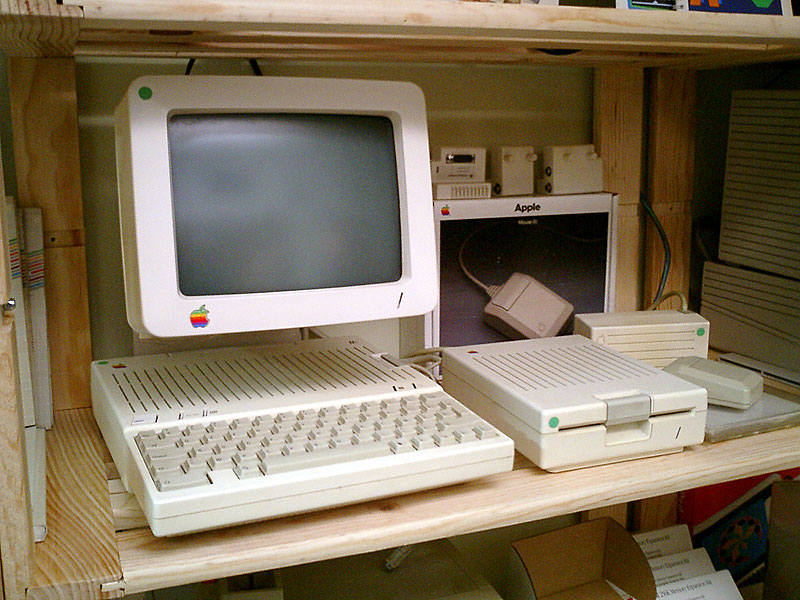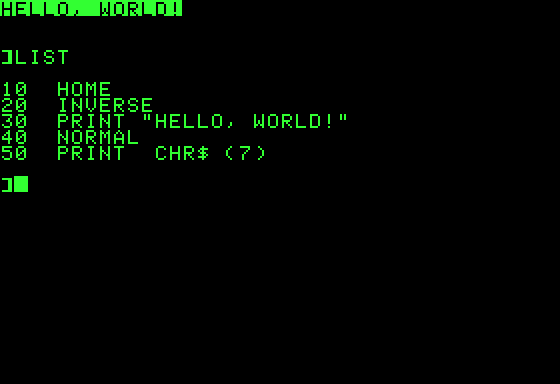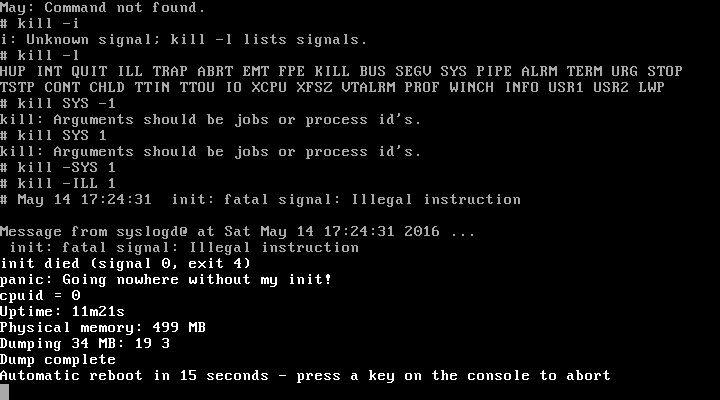|
Apple IIc
The Apple IIc is a personal computer introduced by Apple Inc. shortly after the launch of the Macintosh 128K, original Macintosh in 1984. It is essentially a compact and portable version of the Apple IIe. The IIc has a built-in floppy disk drive and a keyboard, and was often sold with its matching monitor. The ''c'' in the name stands for ''compact'', referring to the fact it is a complete Apple II setup in a smaller notebook-sized housing. The computer is compatible with a wide range of Apple II software and peripherals. The Apple IIc has rear peripheral expansion ports integrated onto the main logic board instead of the expansion slots and direct motherboard access of earlier Apple II models. Apple intended the Apple IIc to require less technical expertise to use. The Apple IIc weighs . It was succeeded by the Apple IIc Plus in 1988. History The Apple IIc was released on April 24, 1984, during an Apple-held event called ''Apple II Forever''. With that motto, Apple proclaimed ... [...More Info...] [...Related Items...] OR: [Wikipedia] [Google] [Baidu] |
Apple IIc Plus
The Apple IIc Plus is the sixth and final model in the Apple II series of personal computers, produced by Apple Computer. The "''Plus''" in the name was a reference to the additional features it offered over the original portable Apple IIc, such as greater storage capacity (a built-in 3.5-inch floppy drive replacing the classic 5.25-inch drive), increased processing speed, and a general standardization of the system components. In a notable change of direction, the Apple IIc Plus, for the most part, did not introduce new technology or any further evolutionary contributions to the Apple II series, instead merely integrating existing peripherals into the original Apple IIc design. The development of the 8-bit machine was criticized by users more interested in the significantly more advanced 16-bit Apple IIGS. History By 1988 the Laser 128 series of Apple II clones was popular enough that it had, '' inCider'' wrote, "won a place in the Apple market, and irritated Apple in the p ... [...More Info...] [...Related Items...] OR: [Wikipedia] [Google] [Baidu] |
Apple Inc
Apple Inc. is an American multinational corporation and technology company headquartered in Cupertino, California, in Silicon Valley. It is best known for its consumer electronics, software, and services. Founded in 1976 as Apple Computer Company by Steve Jobs, Steve Wozniak and Ronald Wayne, the company was incorporated by Jobs and Wozniak as Apple Computer, Inc. the following year. It was renamed Apple Inc. in 2007 as the company had expanded its focus from computers to consumer electronics. Apple is the largest technology company by revenue, with billion in the 2024 fiscal year. The company was founded to produce and market Wozniak's Apple I personal computer. Its second computer, the Apple II, became a best seller as one of the first mass-produced microcomputers. Apple introduced the Lisa in 1983 and the Macintosh in 1984, as some of the first computers to use a graphical user interface and a mouse. By 1985, internal company problems led to Jobs leavin ... [...More Info...] [...Related Items...] OR: [Wikipedia] [Google] [Baidu] |
Plug And Play
In computing, a plug and play (PnP) device or computer bus is one with a specification that facilitates the recognition of a hardware component in a system without the need for physical device configuration or user intervention in resolving resource conflicts. The term "plug and play" has since been expanded to a wide variety of applications to which the same lack of user setup applies. Expansion devices are controlled and exchange data with the host system through defined memory or I/O space port addresses, direct memory access channels, interrupt request lines and other mechanisms, which must be uniquely associated with a particular device to operate. Some computers provided unique combinations of these resources to each slot of a motherboard or backplane. Other designs provided all resources to all slots, and each peripheral device had its own address decoding for the registers or memory blocks it needed to communicate with the host system. Since fixed assignments made expans ... [...More Info...] [...Related Items...] OR: [Wikipedia] [Google] [Baidu] |
Apple 80-Column Text Card
The Apple 80-Column Text Card is an expansion card for the Apple IIe computer to give it the option of displaying 80 columns of text instead of 40 columns. Two models were available; the cheaper 80-column card has just enough extra random-access memory, RAM to double the video memory capacity, and the Extended 80-Column Text Card has an additional 64 kilobytes of RAM, bringing the computer's total RAM to 128 KB. VisiCalc and Disk II made the Apple II very popular in small businesses, which asked the company for 80-column support, but Apple delayed improving the Apple II because for three years it expected that the unsuccessful Apple III would be the company's business computer. The 80-column cards were the alternative. The cards go in the IIe's Auxiliary Slot, which exists in addition to the seven standard Apple II peripheral cards, Apple II peripheral slots present on all expandable Apple II series machines. Although in a separate slot, the card is closely associated with slot #3 ... [...More Info...] [...Related Items...] OR: [Wikipedia] [Google] [Baidu] |
Expansion Cards
In computing, an expansion card (also called an expansion board, adapter card, peripheral card or accessory card) is a printed circuit board that can be inserted into an electrical connector, or expansion slot (also referred to as a bus slot) on a computer's motherboard (see also backplane) to add functionality to a computer system. Sometimes the design of the computer's case and motherboard involves placing most (or all) of these slots onto a separate, removable card. Typically such cards are referred to as a riser card in part because they project upward from the board and allow expansion cards to be placed above and parallel to the motherboard. Expansion cards allow the capabilities and interfaces of a computer system to be extended or supplemented in a way appropriate to the tasks it will perform. For example, a high-speed multi-channel data acquisition system would be of no use in a personal computer used for bookkeeping, but might be a key part of a system used for i ... [...More Info...] [...Related Items...] OR: [Wikipedia] [Google] [Baidu] |
Box-drawing Character
Box-drawing characters, also known as line-drawing characters, are a form of semigraphics widely used in text user interfaces to draw various geometric frames and boxes. These characters are characterized by being designed to be connected horizontally and/or vertically with adjacent characters, which requires proper alignment. Box-drawing characters therefore typically only work well with monospaced fonts. In graphical user interfaces, these characters are much less useful as it is simpler to draw lines and rectangles directly with graphical APIs. However, they are still useful for command-line interfaces and plaintext Comment (computer programming), comments within source code. Some recent embedded systems also use proprietary character sets, usually extensions to ISO 8859 character sets, which include box-drawing characters or other special symbols. Other types of box-drawing characters are block elements, shade characters, and terminal graphic characters; these can be used ... [...More Info...] [...Related Items...] OR: [Wikipedia] [Google] [Baidu] |
PETSCII
PETSCII (PET Standard Code of Information Interchange), also known as CBM ASCII, is the character set used in Commodore Business Machines' 8-bit home computers. This character set was first used by the PET from 1977, and was subsequently used by the CBM-II, VIC-20, Commodore 64, Commodore 16, Commodore 116, Plus/4, and Commodore 128. However, the Amiga personal computer family instead uses standard ISO/IEC 8859-1. History The character set was largely designed by Leonard Tramiel (the son of Commodore CEO Jack Tramiel) and PET designer Chuck Peddle. The graphic characters of PETSCII were one of the extensions Commodore specified for Commodore BASIC when laying out desired changes to Microsoft's existing 6502 BASIC to Microsoft's Ric Weiland in 1977.mirror The VIC-20 used the same pixel-for-pixel font as the PET, although the characters appeared wider due to the VIC's 22-column screen. The Commodore 64, however, used a slightly re-designed, heavy upper-case font, es ... [...More Info...] [...Related Items...] OR: [Wikipedia] [Google] [Baidu] |
Code Page 437
Code page 437 ( CCSID 437) is the character set of the original IBM PC (personal computer). It is also known as CP437, OEM-US, OEM 437, PC-8, or MS-DOS Latin US. The set includes all printable ASCII characters as well as some accented letters (diacritics), Greek letters, icons, and line-drawing symbols. It is sometimes referred to as the "OEM font" or "high ASCII", or as "extended ASCII" (one of many mutually incompatible ASCII extensions). This character set remains the primary set in the core of any EGA and VGA-compatible graphics card. As such, text shown when a PC reboots, before fonts can be loaded and rendered, is typically rendered using this character set. Many file formats developed at the time of the IBM PC are based on code page 437 as well. Display adapters The original IBM PC contained this font as a 9×14 pixels-per-character font stored in the ROM of the IBM Monochrome Display Adapter (MDA) and an 8×8 pixels-per-character font of the Color Graphics Adapter ( ... [...More Info...] [...Related Items...] OR: [Wikipedia] [Google] [Baidu] |
Graphical User Interface
A graphical user interface, or GUI, is a form of user interface that allows user (computing), users to human–computer interaction, interact with electronic devices through Graphics, graphical icon (computing), icons and visual indicators such as secondary notation. In many applications, GUIs are used instead of text-based user interface, text-based UIs, which are based on typed command labels or text navigation. GUIs were introduced in reaction to the perceived steep learning curve of command-line interfaces (CLIs), which require commands to be typed on a computer keyboard. The actions in a GUI are usually performed through direct manipulation interface, direct manipulation of the graphical elements. Beyond computers, GUIs are used in many handheld mobile devices such as MP3 players, portable media players, gaming devices, smartphones and smaller household, office and Distributed control system, industrial controls. The term ''GUI'' tends not to be applied to other lower-displa ... [...More Info...] [...Related Items...] OR: [Wikipedia] [Google] [Baidu] |
MouseText
MouseText is a set of 32 graphical characters designed by Bruce Tognazzini and first implemented in the Apple IIc. They were then retrofitted to the Apple IIe forming part of the Enhanced IIe upgrade. A slightly revised version was then released with the Apple IIGS. By including box-drawing characters, MouseText made it possible to display simple text user interfaces resembling the Macintosh graphical user interface. Since the Apples lacked the ability to display user-defined characters in text mode, all GUI-like displays beyond crude ASCII art approximations had to use the slower and more memory-hungry graphical mode before MouseText was available. MouseText resulted in an eightfold increase in display speed for mouse applications, bringing such text-based applications as word processors up to the same speed as the original Macintosh. Word processors running on the two computers would not be confused with one another, however, as the mouse under MouseText would move in discrete j ... [...More Info...] [...Related Items...] OR: [Wikipedia] [Google] [Baidu] |
Applesoft BASIC
Applesoft BASIC is a dialect of Microsoft BASIC, developed by Marc McDonald and Ric Weiland, supplied with Apple II computers. It supersedes Integer BASIC and is the BASIC in Read-only memory, ROM in all Apple II series computers after the original Apple II model. It is also referred to as FP BASIC (from floating-point arithmetic, floating point) because of the Apple DOS command FP used to invoke it, instead of INT for Integer BASIC. Applesoft BASIC was supplied by Microsoft and its name is derived from the names of both Apple Computer and Microsoft. Apple employees, including Randy Wigginton, adapted Microsoft's interpreter for the Apple II and added several features. The first version of Applesoft was released in 1977 on cassette tape and lacked proper support for high-resolution graphics. Applesoft II, which was made available on cassette and disk and in the ROM of the Apple II Plus and subsequent models, was released in 1978. It is this latter version, which has some synt ... [...More Info...] [...Related Items...] OR: [Wikipedia] [Google] [Baidu] |
Illegal Opcode
An illegal opcode, also called an unimplemented operation, unintended opcode or undocumented instruction, is an instruction to a CPU that is not mentioned in any official documentation released by the CPU's designer or manufacturer, which nevertheless has an effect. Illegal opcodes were common on older CPUs designed during the 1970s, such as the MOS Technology 6502, Intel 8086, and the Zilog Z80. Unlike modern processors, those older processors have a very limited transistor budget, and thus to save space their designers often omitted circuitry to detect invalid opcodes and generate a trap to an error handler. The operation of many of these opcodes happens as a side effect of the wiring of transistors in the CPU, and usually combines functions of the CPU that were not intended to be combined. On old and modern processors, there are also instructions intentionally included in the processor by the manufacturer, but that are not documented in any official specification. Overvi ... [...More Info...] [...Related Items...] OR: [Wikipedia] [Google] [Baidu] |







